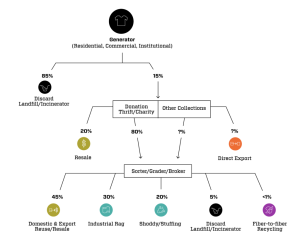There’s more to the circular economy than recycling

According to a new survey, only around 15% of old garments and other textiles in the United States are reused or recycled, with the remaining 85% ending up in landfills or incinerators.
More information for customers about how to dispose of their worn textiles, according to researchers from the National Institute of Standards and Technology (NIST), is a substantial barrier to greater reuse and recycling. However, they contend that customer awareness is limited.
Better sorting and grading technologies, smarter labeling and digital product identification, enhanced recycling procedures for specific synthetics that are now not recyclable, standardized language and classifications, and improved data collecting are all recommended in the paper.
The National Institute of Standards and Technology’s paper, Facilitating a Circular Economy for Textiles, is based on a recent workshop that brought together manufacturers, industry associations, recyclers, waste managers, researchers, policymakers, and several big fashion brands.
‘Textiles are one of the fastest expanding waste stream categories,’ says Kelsea Schumacher, an environmental engineer with NIST and report co-author. ‘However, there are numerous potential in this sector to minimize waste, which would have significant economic and environmental benefits.’
Textiles are defined as clothing, shoes, bedding, towels, upholstery materials, and carpeting in the report. Clothing, on the other hand, is the most common type of textile found in municipal waste. In 2018, the most recent year for which data is available, each person in the United States disposed of 47kg of textiles on average.
The report’s authors gathered information from a variety of sources to build a flow diagram depicting what happens to textiles in the United States after they are given or disposed.
The study was conducted as part of NIST’s larger circular economy program, which has primarily focused on ways to keep plastics moving within the economy until now.
‘There’s more to the circular economy than recycling,’ says co-author Amanda Forster. ‘It’s about keeping items in usable shape for as long as possible, then finding a means to recycle them that protects as much of their value as possible, and only sending them to the landfill as a last resort,’ says the author.

